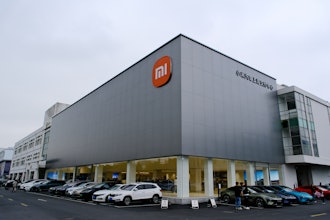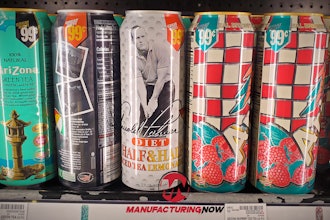The Japanese term for 'continuous improvement' has come to represent a new culture for many U.S. manufacturers, as well as a new opportunity to compete.
| A kaizen event takes place at a National Can Corp. plant in Kent, Wa. |
During the same period, U.S. automakers watched helplessly as Japan's new wave of unpretentious, gas-saving compact cars began to siphon off their revenue. More than anything, it was probably this culture change - spurred by the energy crisis and its resulting fears and high prices - that eventually brought U.S. manufacturers face to face with their own destiny. They realized that survival depended upon their ability to level the playing field and do what the Japanese were doing - and preferably do it better.
U.S. manufacturers learned that the Japanese were achieving their miraculous efficiencies with lean manufacturing concepts. Lean manufacturing, which uses kaizen methods to reach its goal, is just what the name implies: manufacturing operations that have had the fat cut away. "There are two goals of lean manufacturing," says Patrick Wolfe, TPM consultant for the Japan Institute of Plant Maintenance in Atlanta, GA. "The first is to create a one-piece flow type of environment; the second is to address your problems when they happen." He says that in a properly run, lean operation, defects or problems are discovered immediately. This contrasts with less efficient operations that must shut down entire lines to learn the root of problems, then, due to the pressure of a line stoppage, opt for a quick-fix solution. The lean process, he says, "forces you to not put what we call a band-aid on the problem."
When confronted with the proposition of becoming "lean," American automobile manufacturers turned to their Japanese competitors for information and answers. What were they doing to cut costs and still produce cars that were more fuel-efficient and cheaper than American-made cars? They learned that the key to the Japanese success was the Toyota Production System (TPS). TPS, developed by Taiichi Ohno, an engineer with Toyota Motor Co., was the culmination of more than 23 years of research and analysis of both American and Japanese manufacturing systems. Toyota's success as a car manufacturer, especially in the 1970s was attributed to TPS, and American manufacturers sought to emulate it.
With the help of a visionary like Dr. D. Edwards Deming - the U.S. matematician who traveled to Japan after World War II to help its citizens return to productivity - manufacturers like Ford and Chrysler visited the Toyota plant in Nagoya, Japan, and witnessed TPS first hand. "The Americans thought they would have to enter the plant secretively," says Enrique Mora, a San Diego, CA-based manufacturing consultant. They were surprised, he says, when "Toyota invited them in with open arms and threw a big party for them. The Japanese told the Americans they could take all the pictures, all the notes and ask all the questions that they may find interesting."
These initial visits led to many others. The Americans became intimately familiar with the Toyota Production System, which "is based on being lean," says Geoffrey Mika, senior consultant with Productivity, Inc., in his book Kaizen: Event Implementation. "This means: Manufacture only what is needed by the customer, when it is needed, in the quantities ordered." Furthermore, the process requires that the manufacturing process be "done in a way that minimizes the time it takes to deliver the finished goods, the amount of labor needed, the floor space required and does it with the highest quality usually at the lowest cost."
Kaizen is one of the original tools of TPS, developed in the early 1960s to solve problems in the Toyota Production System. Today, the kaizen event is common and acceptable practice by many different types of manufacturing operations, for all kinds of reasons.
"The word kaizen really means many things," says Carol Shaw, associate dean of engineering and director at the Center for Competitive Change, an Ohio-based training and consulting service linked with the University of Dayton. "It is a learning event. We think of it as a focused time of continuous improvement. The body of knowledge of kaizen includes a focus on reducing waste, getting to one-piece flow from batch manufacturing, reducing set-up times, and reducing lead times. We also focus on improved quality, safety for the workers and ergonomics."
Applied kaizen: MCCA and Gems Sensors
"Kaizen is very effective in a fast paced, high volume environment," says Dan Russell, total productive maintenance (TPM) manager at the Matsushita Compressor Corp. of America plant in Mooresville, NC. "If your cycle time is off one or two seconds, for example, you can lose a 3-year capacity." The Matsushita plant manufactures up to 2.2 million rotary compressors for air conditioners each year, which is considered high volume, according to Russell. To facilitate this output, the MCCA plant floor is configured in departments. There are three areas and five departments within each area. Each area has an ongoing kaizen for a specific quality problem. Kaizen is scheduled at MCCA within the company's TPM program. Every week a department goes down for a TPM activity, which may include kaizen, planned maintenance or training.
"These activities are as much of a goal as meeting production schedules," says Russell, and supervisors are very key in planning for these events. "We'll move people around so we can get the people we need off the line. A supervisor may take their spot or a person from another department may fill in so we can continue to run. Or we may run at 50% on some lines."
The goal of kaizen at MCCA is improvement. The events are focused on an issue that usually falls within the parameters of three areas: downtime, quality and model improvement. The focused subject of a kaizen event can be tracked through the company's overall equipment efficiency (OEE) ratio. The OEE indicates the amount of time a machine is producing quality products. Downtime and defects lower an OEE ratio, thus exposing an issue for a kaizen event.
"We will take the number-one downtime issue for the plant," says Russell, "and we'll improve that. We'll create a group for it. We focus on our number ones," he says, "because they'll show the biggest change to the bottom line. We call it cascade thinking from the top down and then we track our results back to the top or to the bottom line," says Russell.
The TPM and kaizen teams at MCCA are dynamic, cross-functional and multi-level. The make-up of the team changes, depending on the project. "Depending on the project, we will use an operator, a maintenance tech and an engineer, plus a quality person and a manager," says Russell. "If it's a problem that we can track to a vendor, we'll include a purchasing member. Anyone in the factory can be on any team," a many-hands process that experts say results in the quickest solution.
Gems Sensors, Inc., a Plainville, CT-based manufacturer of switches and indicators, also uses kaizen. The company conducts two to three kaizen events per month in its 85-cell plant. Each event runs between three and five days, plus the time it takes to prepare for the event, which includes training, goal-setting and identifying the team. Training the team can take from two hours to two days; teams have included up to 15 people. At least half of the team is voluntary. The company conducts "kanban" kaizens, which focus on inventory-control and a include a supplier member, and manufacturing kaizens.
"When we work on a manufacturing cell, we make sure we have at least one of the associates that runs a cell or builds a product in that cell to make sure we get the buy-in and some of the ideas that have been bubbling there for a while," says Mike Balas, vice president of manufacturing operations. "It is probably one of our most powerful tools."
To avoid downtime on the line during a kaizen event, orders are built ahead of time. If there isn't to do that, Gems Sensors creates a rudimentary cell duplication so the product can be built on the side. Balas says kaizen is one of the best processes for sorting out the flow of a process.
"Kaizen is great for hands-on things. You can take benches apart and you can reconfigure them," says Balas. "You can build fixtures. Kaizen is really good for the stuff you can really do - the here and now."
Changing cultures
Aware of the natural human tendency to resist change, Gems Sensors requires its employees go through a "change model" in their kaizen training. The change model indicates how quickly an employee can adapt to change. "From a psychological standpoint, when you first introduce change to someone, the immediate response is resistance and denial," says Balas. The next step is passive resistance, followed by a willingness to try the change, which ultimately leads to the acceptance that this is the way things are going to get done.
"To solve a problem you have to eliminate the cause of that problem and the cause of that problem is often a cultural reason," says consultant Mika. Kaizen, he adds, is 95% cultural change and 5% physical.
Experts stress that kaizen does not stand alone. It must fit within the strategy of a manufacturing system. A single kaizen event does not last. It is part of a cultural change that may take a number of years to measure. In addition, kaizen is not going to solve all your problems. Success with kaizen requires regularity, organization, investment and commitment.
Consultant Mika has attended more than 300 kaizen events throughout the world. All of them have had good results, he says, although some have had more consistently good results than others.
"An important benefit of kaizen is that it is an awakening," he says "It allows people to very quickly see that things can change and that paradigms can be broken." Another benefit is that it shows people that there can be participative management. People get involved and see that they are valuable. Kaizen equips people with new abilities to make the right decisions and solve problems.
The number-one disadvantage of kaizen, say experts, is regression, which is the result of not placing enough emphasis on the cultural aspect of kaizen. "The less emphasis you place on understanding the new philosophy, the more regression you will have," says Mika. "If people don't understand why these changes were made and do not fully believe in these changes and are not totally committed, then at some point, the process will revert back to what it was before you did anything."
Often, management thinks that the kaizen responsibilities can be delegated down to a group of people on the shop floor and this will change the organization. This is flawed because the philosophy is that an entire system must change, not just a part of it. "Kaizen does not rearrange the furniture," says Mika. "It's a new belief, a new religion, a new language; it's not 'same old' in any way. It is affected by and it does affect every element of a business."
The future of kaizen
"There are a lot of companies that don't do it, and I honestly don't know why they don't," says Balas. "If you try to change a culture, what better way to do it than to give people the opportunity to change the environment around them? Let's get people together to solve our biggest problems, quickly and let's get people to continuously improve our organization."
Balas says he anticipates that more companies will try kaizen and that those that have been using it will become more powerful. Can a manufacturer stay competitive without kaizen? Balas doesn't think so. Neither does consultant Mora agrees, adding that we should remember what happened to the U.S.-made television.
"Companies will keep closing their doors if they don't implement lean manufacturing and kaizen," he says. "It's that simple. In 1970, there were about 100 manufacturers of TV sets in America. Today there are none. Nobody manufactures TV sets in America. They all are imported. Do we want this to happen with each and every one of our industries?"
Through the Toyota Production System, auto makers have had the most exposure to kaizen and its proven successes. Most have taken advantage of its power in some way. In 1992, for example, General Motors sent a team of engineers to Japan at the invitation of Toyota after GM closed an assembly plant in Oakland, CA. The plant later reopened as a joint venture between Toyota and General Motors, known as New United Motors Manufacturing, Inc. Consultant Mika was a member of one of the NUMMI engineering teams that went to Japan to learn TPS. He was trained by Toyota for nearly four months and helped implement TPS at the reopened plant in California.
Today Mika believes many other U.S. industries are ready for kaizen. These include distribution, computers, banking, insurance and others. "Any time you want to determine what is value-added and what is not," he says, "kaizen is applicable." And as Mora notes, kaizen's "environment of camaraderie" has shown that, when nurtured, it will lead to improvement every time.
Sidebar
Kaizen Concepts and Context
The seed of the concept was created after a 1949 strike against the failing Toyota Motor Co. in Japan. The strike was settled when president Kiichiro Toyoda resigned, admitting to the striking workers that he was responsible for the company's problems. His departure was predicated on an agreement that no worker within the company would lose his job. In return, the workers would agree to strive to continuously improve Toyota.
The TPS process, which incorporates kaizen techniques, eventually became a worldwide standard. It has been credited by U.S. automakers for bringing significant improvements to their production process.
The culture of Kaizen focuses on eliminating waste in all systems and processes of an organization. Instead of Quality Control, which suggests a lack of trust from the management, operators make suggestions of techniques to error-proof the manufacturing process. The guaranteed quality of the product creates pride in each employee.
The philosophy of Kaizen includes the original 5S concept, which helps workers concentrate on an organized work place and standardized work procedures. The five philosophies are: Seiri (Sort) - eliminate unnecessary items for the workplace; Seiton (Set in order) - use efficient and effective storage methods; Seiso (Shine) - thoroughly clean the work area; Seiketsu (Standardize) - ensure that all employees participate in making the best standards; and Seiketsu (Sustain) - define a new status quo and resist the human tendency to return to the old one.


















